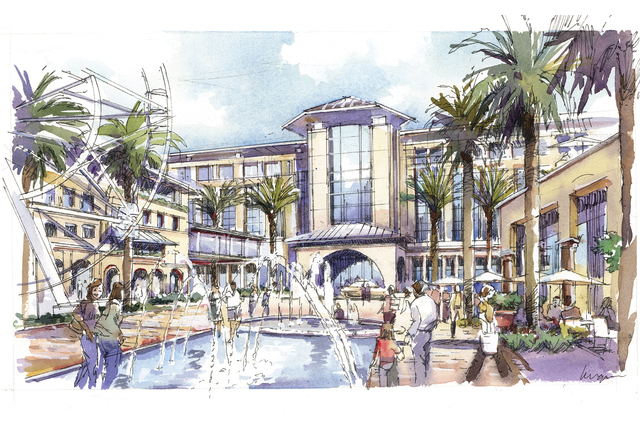Touted as the world’s largest healthcare project, the 170-unit, $1.2 billion Union Village finally broke ground on October 8 in this Las Vegas suburb.
The village, which has been in the works since 2010, is set to start construction early next year, with the first building being an acute-care hospital on 38 acres, according to the Las Vegas Journal-Review. The Valley Health System purchased this land for this facility, which will be its sixth hospital in the state.
The complex is slated to include a 315-bed hospital, and 200-bed nursing facility with long-term acute care, Alzheimer’s care, and assisted living, Healthcare Finance News reports. The hospital and medical center are scheduled to open in late 2016, according to the Journal-Review.
The goal of this village, according to its website, is to create a live-work-play environment that integrates world-class healthcare with retail, entertainment, cultural and residential centers. Nevada Gov. Brian Sandoval, who attended the groundbreaking, calls the village “a Gateway between the city of Henderson and all of Nevada.” And its medical facilities will provide all levels of healthcare whatever the age of the patient.
In April 2011, the city of Henderson approved an agreement to sell a 151 acres of city-owned property for this project for $11.6 million, according to the Las Vegas Sun’s website. At the time it quoted David Mathis, president and CEO of the Nevada Health Care Alliance, who said Union Village would provide a much-needed boost to medical infrastructure in Southern Nevada.
Craig Johnson, a senior living veteran of 20 years and the founder of Union Village, said the village would consist of four parts: the medical facilities in Union Centre; retail, offices, and residential apartments in Union Plaza; a senior community in Union Place; and a civic and cultural center in Union Park.
The buildout is expected to take a decade, reports Healthcare Finance News. The project will create 5,000 construction jobs and 12,000 healthcare and retail jobs, as well as contribute $5 billion to local and state coffers through income and property taxes over its anticipated 80-year lifespan.
Housing for 1,000 seniors will be built, along with at least 350 market-rate condominiums, Johnson told the Journal-Review. The village complex is also expected to include a movie theater, health club and hotel.
The Building Team includes: Hammes Company, Haskell, HKS, Juliet Cos., and Penta Building Group.
Related Stories
| Nov 15, 2010
Gilbane to acquire W.G. Mills, Inc.
Rhode Island-based Gilbane Building Company announced plans to acquire W.G. Mills, Inc., a construction management firm with operations based in Florida. The acquisition will dramatically strengthen Gilbane’s position in Florida’s growing market and complement its already established presence in the southeast.
| Nov 11, 2010
Saint-Gobain to make $80 million investment in SAGE Electrochromics
Saint-Gobain, one of the world’s largest glass and construction material manufacturers, is making a strategic equity investment in SAGE Electrochromics to make electronically tintable “dynamic glass” an affordable, mass-market product, ushering in a new era of energy-saving buildings.
| Nov 11, 2010
Saint-Gobain to make $80 million investment in SAGE Electrochromics
Saint-Gobain, one of the world’s largest glass and construction material manufacturers, is making a strategic equity investment in SAGE Electrochromics to make electronically tintable “dynamic glass” an affordable, mass-market product, ushering in a new era of energy-saving buildings.
| Nov 11, 2010
USGBC certifies more than 1 billion square feet of commercial space
This month, the total footprint of commercial projects certified under the U.S. Green Building Council’s LEED Green Building Rating System surpassed one billion square feet. Another six billion square feet of projects are registered and currently working toward LEED certification around the world. Since 2000, more than 36,000 commercial projects and 38,000 single-family homes have participated in LEED.
| Nov 10, 2010
$700 million plan to restore the National Mall
The National Mall—known as America’s front yard—is being targeted for a massive rehab and restoration that could cost as much as $700 million (it’s estimated that the Mall has $400 million in deferred maintenance alone). A few of the proposed projects: refurbishing the Grant Memorial, replacing the Capitol Reflecting Pool with a smaller pool or fountain, reconstructing the Constitution Gardens lake and constructing a multipurpose visitor center, and replacing the Sylvan Theater near the Washington Monument with a new multipurpose facility.
| Nov 9, 2010
Just how green is that college campus?
The College Sustainability Report Card 2011 evaluated colleges and universities in the U.S. and Canada with the 300 largest endowments—plus 22 others that asked to be included in the GreenReportCard.org study—on nine categories, including climate change, energy use, green building, and investment priorities. More than half (56%) earned a B or better, but 6% got a D. Can you guess which is the greenest of these: UC San Diego, Dickinson College, University of Calgary, and Dartmouth? Hint: The Red Devil has turned green.
| Nov 9, 2010
12 incredible objects being made with 3D printers today
BD+C has reported on how 3D printers are attracting the attention of AEC firms. Now you can see how other creative types are utilizing this fascinating printing technology. Among the printed items: King Tut’s remains, designer shoes, and the world’s smallest Rubik’s Cube.
| Nov 9, 2010
U.S. Army steps up requirements for greening building
Cool roofs, solar water heating, and advanced metering are among energy-efficiency elements that will have to be used in new permanent Army buildings in the U.S. and abroad starting in FY 2013. Designs for new construction and major renovations will incorporate sustainable design and development principles contained in ASHRAE 189.1.










